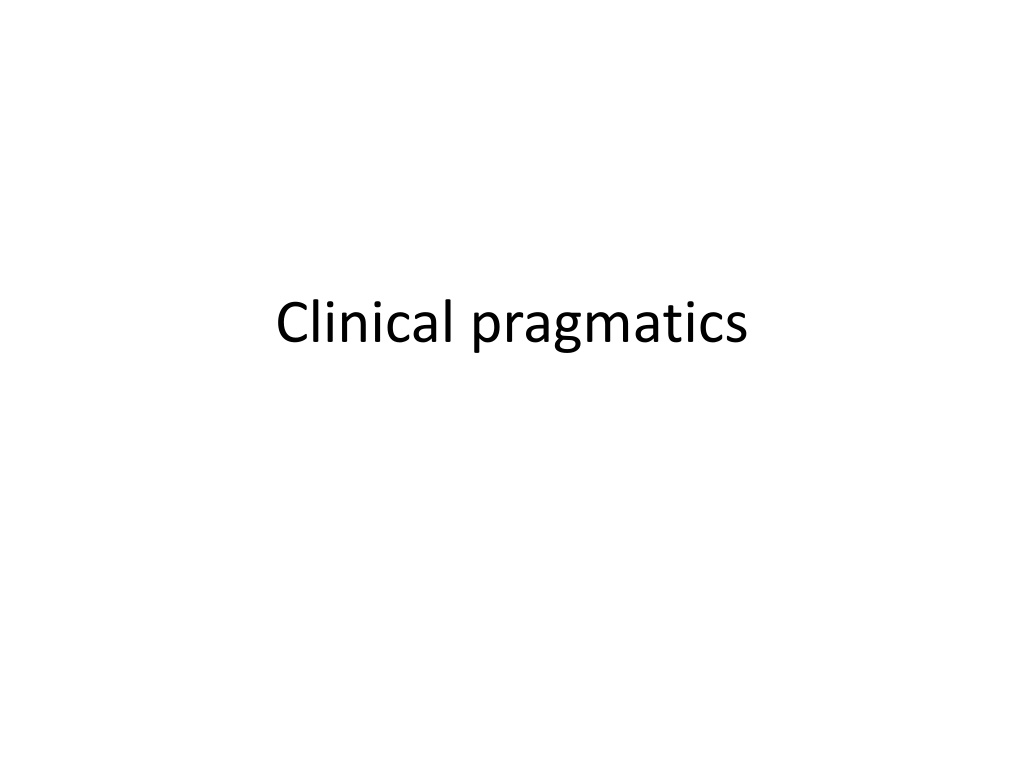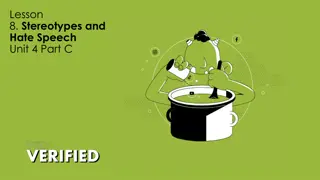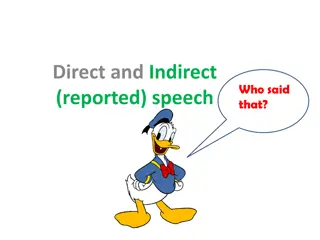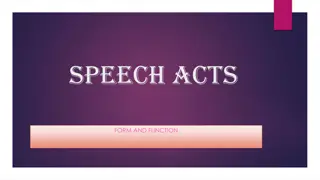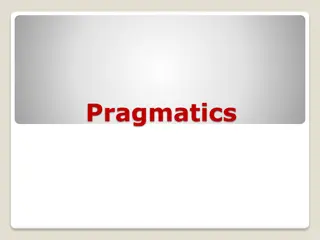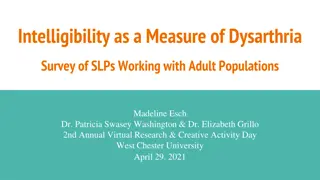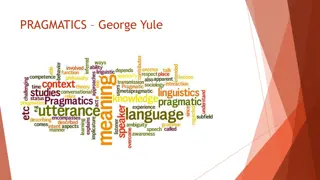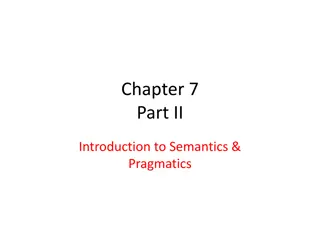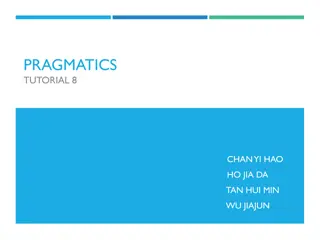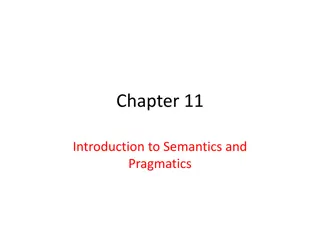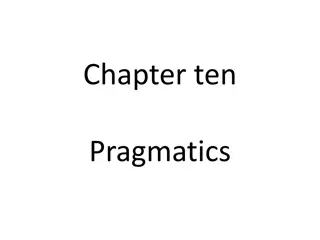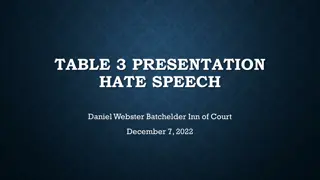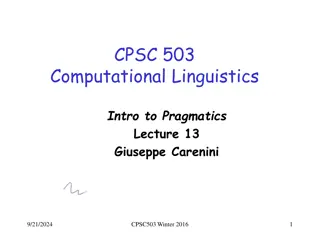Understanding Pragmatics in Speech and Communication
Explore the world of clinical pragmatics, speech acts, direct vs. indirect speech acts, and the works of Austin and Searle in understanding how language goes beyond semantics. Delve into felicity conditions and conventions that govern effective communication and learn about assessing pragmatic skills.
Download Presentation

Please find below an Image/Link to download the presentation.
The content on the website is provided AS IS for your information and personal use only. It may not be sold, licensed, or shared on other websites without obtaining consent from the author. Download presentation by click this link. If you encounter any issues during the download, it is possible that the publisher has removed the file from their server.
E N D
Presentation Transcript
Problem areas Reference and presupposition Context-dependent disambiguation Implicatures Speech acts
Speech as an act Some utterances are more than a description of a state-of-affairs: I have a gun. (threat) You re an idiot. (insult) I need a pen. (request) I ll settle my debt tomorrow. (promise) Pay up or you ll see your pictures on the web. (blackmail) If an utterance is not a description of the world, it cannot be interpreted with the tools of semantics in terms of truth values.
Direct versus indirect speech acts It needs some more salt. It s tasteless! I could do with a bit of salt. Can you reach the salt? Could you pass the salt? Give me the salt!
Austin 1955, How to act with words locution: the actual words used by the speaker and their semantic meaning illocution: what the speaker is doing by uttering those words perlocution: the actual result of the locution a locution may express more than one illocution perlocution may differ from illocution.
Searle (1971): Felicity conditions A speech act is not true or false but felicitous or non- felicitous. For a speech act to be felicitous, certain conditions must be met If you don t stop that, I won t eat my cake. the act cannot have the desired effect I m ordering the sun to rise tomorrow. ignores the current state of the world I ll/you should eradicate poverty in the world. the act cannot be performed I promise to punch you in the nose. mismatch between performative verb and intended act
The conditions are conventions similar to Grice s maxims content conditions: depends on speech act, e.g., requested or promised events must be future events preparatory conditions: the promised act can be performed sincerity condition: the illocutionary act is the speaker s genuine intention general conditions: the utterance must make sense to the speaker and the hearer
Childrens Conversational Checklist (Bishop,1998) 70 items scored as does not apply (0), applies somewhat (1), and definitely applies (2). Items fall into 9 categories: A. Speech intelligibility and fluency B. Syntax C. Inappropriate initiation D. Coherence E. Stereotyped conversation F. Use of conversational context G. Conversational rapport H. Social relationships I. Interests
Childrens Conversational Checklist Some example items: C. Inappropriate initiation Talks too much Keeps telling people things they know already D. Coherence Has difficulty telling a story, or describing what he has done, in an orderly sequence of events Uses terms like he and it without making clear what he is talking about
Childrens Conversational Checklist (cont) E. Stereotyped conversation Will suddenly change the topic of conversation Has favorite phrases and sentences which he will use a great deal, sometimes inappropriately F. Use of conversational context Tends to be over literal May say things which are tactless or socially inappropriate G. Conversational rapport Ignores conversational overtures from others Seldom or never looks at the person he is talking to
Childrens Conversational Checklist Fairly good clinician inter-rater reliability and internal consistency -- in the .80 range. Pragmatic composite score (the 38 items) discriminates significantly between autistic, pragmatic language impaired (without autism), other SLI, and typically developing children. Low correlations between teacher/clinician ratings and parent ratings (+.48 on pragmatic composite score)
Clinical populations Developmental disorders: Specific language impairment Autistic spectrum disorders Mental retardation Emotional and behavioural problems (e.g. Attention Deficit Hyperactivity Disorder) Acquired disorders stroke, brain tumour traumatic brain injury neurodegenerative disorders (e.g. Alzheimer, Parkinson) schizophrenia
Likely sources of pragmatic impairment Structural linguistic impairment e.g. speech act deficiencies may be explained by an inability to form syntactically correct questions Cognitive deficits speed of information processing, working memory impairments of executive functioning (sustaining attention, impulse control, flexibility) Impaired Theory of Mind skills
Developmental language disorder Specific language impairment (SLI) poor language performance with normal nonverbal intelligence and normal hearing morphosyntactic deficits (Leonard et al 2003) object naming problems (McGregor et al 2002, Alt et al 2004) phonological deficits (Aguilar-Mediavilla et al. 2002) impaired phonological short term memory (non-word repetition) (Briscoe et al 2001) poorer verbal working memory capacity (in competing language processing task: T/F question + recall of last word or sentence) sluggish attention shifting (rapid serial visual presentation task: detect two consecutive target stimuli) (Lum et al 2007) pragmatics??
SLI pragmatics inadequate conversational responses (Bishop et al 2000) problems using context to understand implied meanings or to resolve ambiguity with the help of context, (Rinaldi 2000, Leinonen et al 2003) is it a problem of rapid inferential processes?
Reference Specification -- Testing Procedure, de Villiers, 1988 Examiner and child play a referential communication game. The child sees a picture that the examiner cannot see. S/he has to describe an event that is happening in part of the picture so that the examiner can pick out the person or object involved in the event from a set of similar people or objects. In some trials there is a distinctive property that distinguishes the referent. In others it is the location or action of the referent that must be mentioned. In this way the linguistic form that must be produced increases in complexity from adjectives to prepositional phrases and finally to relative clauses.
Here are two policemen. c. The Psychological Corporation
Tell me what is happening in the red box. I need to know which policeman it is. c. The Psychological Corporation
Here are two boys. c. The Psychological Corporation
Tell me what is happening in the red box. I need to know which boy it is. c. The Psychological Corporation
Development of reference specification in typically-developing and language-impaired children. Spontaneous production of form and function before any prompts.
Development of reference specification in typically-developing and language-impaired children. Production of form and function following all prompts.
Story comprehension: Ryder & Leinonen Ben was having a bring-your-bear birthday party. He told Tom and Maxie and Rosie and Sue when they were out at the swings. They said they d all come and they told their mums and their dads. I ve never heard of a bring-your-bear birthday party before Maxie said. Tom and Maxie and Rosie and Sue made birthday cards for Ben. Sue made a big card shaped like a bear and a much smaller card to give from her teddy bear. Rosie said Ben was having a Big Bear, a real one, at his party. Ben s making it up Maxie said. The bears needed special clothes for the party. Tom and Maxie and Rosie and Sue looked in Sue s box of old dressing-up clothes for things to wear. My bear will look best Maxie said. Becausehe s the biggest! Sue and her mum went shopping for Ben s birthday present. They saw Tom and Maxie and Rosie at the shops. They were all looking for presents for Ben. Rosie said that the Big Bear would do tricks at Ben s party. Big Bears don t do tricks, Maxie said. They live in the woods . At playgroup they all sang Happy Birthday, Dear Ben although Ben wasn t four until the next day. Mrs. Samara gave Ben a kiss. Ben told Mrs. Samara that a big bear was coming to his party. Mrs. Samara said she d once seen a big bear but she d never met one at a party. She thought a big bear might scare the teddy bears. Not my bear, Maxie said My bear is brave, just like me! At the party, Ben was dressed as Paddington Bear, with boots and a hat. There were lots of bear games, and bear eats and bear treats that were hidden. Tom and Rosie and Maxie and Sue all had to find them. Where sBen s big bear? Maxie said. I knew there wouldn t be one! Then, the door opened and in came Ben s big bear! He went GRRRRRR! Maxie hid under the table. Rosie told Maxie not to be scared, it was just Ben s dad dressed up. I know that Maxie said. it was my bear who was scared, not me . Maxie got used to the bear being there. He and Ben helped the Big Bear to do his tricks. They made Rosie s small bear appear out of a hat. I ll do the magic words Maxie said. Tom and Rosie and Maxie and Sue sang, Happy Birthday, Dear Ben, and Ben blew out all the candles on his Bear-Cake all by himself. I like this bear party said Rosie. My bear says it s the best bear party ever! Maxie said.
Ryder & Leinonen Questions Reference Questions Who sang Happy Birthday, Dear Ben? What did Tom and Rosie and Maxie and Sue have to find? Who made Rosie s small bear appear out of a hat? Enrichment Questions What is a bring-your-bear birthday party? What are special clothes? What tricks did the bear do? Implicature Questions Where had Mrs. Samara seen a big bear? How did Maxie know there wasn t going to be a big bear? Why did Maxie say it was his teddy bear who was scared?
Ryder & Leinonen 2003 Leinonen et al 2003: children with SLI do worse than their age-matched controls
Left hemisphere damage most common form of language impairment is aphasia: fluent (Wernike s) or non-fluent (Broca s) pragmatic deficits also occur narrative coherence, discourse organisation (Coelho & Flewellyn 2003) Gricean implicatures in literally problematic two- sentence exchanges (Kasher et al 1999) also in non-verbal contexts: interpretation of metaphorical paintings
LHD and non-verbal implicatures (Cutica et al 2006) shown story videos with an actor performing a gesture Task: select a picture that represents the actor s communicative intentions patients do badly if the story involves deceit or irony
Direct acts: A child (A) is walking with her mother (B) along the road. A tags onto B s dress and holds her arms up. The alternatives for A s thought are (a) B picks A up (b) B washes A s hands (c) A is carrying a doll (d) B looks at some plants Simple deceits: In a classroom, children are doing math exercises. One child (A) is holding a book to hide the comic strips inside. The teacher (B) comes over, suspiciously. A hides the comics under the desk and shows the teacher her book. The alternatives for A s thought are (a) B pats A s head with approval (b) A is reprimanded (c) A, C, and D are playing together (d) A and C are reading a comic Simple Ironies: Two children A and B are playing with lego. Together they are building a fairly high tower. B knocks the tower over. A claps. The alternatives for A s thought are (a) A is sad (b) A is happy (c) B is drawing (d) A and B are playing the piano
Right hemisphere damaged patients stroke or tumour patients typically intact structural linguistic abilities odd conversational behaviour rambling, jumping from topic to topic problems comprehending non-literal meanings and indirect speech acts
Right hemisphere damage problems using story context to answer questions, especially discourse connectives (Dipper et al 1997) impaired comprehension of idioms, bias towards literal interpretation (Papagno et al 2006) problems interpreting sarcastic counterfactual comments, they miss the sarcastic intent (McDonald 1999) inability to appreciate humour maintain coherence between the context and the critical utterance (mostly right frontal lobe lesions) (Brownell & Gardner 1983)
ToM and non-literal language By theory of mind we mean being able to infer the full range of mental states (beliefs, desires, intentions, imagination, emotions, etc.) that cause action. In brief, to be able to reflect on the contents of one s own and other s minds. (Baron- Cohen 2000: 3) to understand implicatures the hearer must establish the speaker s communicative intention the listener must make certain inferences about the speaker s mental state or beliefs second order ToM reasoning (deciding what X believes about Y s beliefs) is strongly related to the ability to interpret non- literal meanings, to distinguish lies from jokes (Winner et al 1998) RHD patients cannot attribute second-order intentional states (Griffin et al 2006, Happe et al 1999) But LHD patients do not display impaired ToM performance
The Sally-Anne task (Baron-Cohen; Wimmer & Perner, 1983) Typically developing: https://www.youtube.com/watch?v=41jSdOQQ pv0 Autistic: https://www.youtube.com/watch?v=jbL34F81Rz 0 Wimmer and Perner 1983
A Sally-Anne feladat
Griffin et al 2006 Cartoons physical inference: inference about prior physical events first-order ToM: assessment of ignorance or false belief of a character second-order ToM cartoons: awareness of either deception or fooling in which one character was aware of what the other character knew or did not know, and was taking advantage of this knowledge
Is there anything that X doesn t know, or is unaware of, that is important to the humour of this cartoon? If yes, what is it? Is X trying to trick or fool Y?
Faux pas task A man called Tim spills some coffee in a restaurant. He turns to a customer and, believing him to be a waiter, says I ve spilt my coffee. Would you be able to mop it up? (Baron-Cohen et al 1999, autistic patients) Steve, a scientist, is traveling on a plane with his wife. Suddenly, he is tapped on the shoulder by another scientist. Steve looks up, sees that he knows this man, and says "Oh hi! How nice to run into you! Let me introduce you to my wife, Betsy. Betsy, this is Jeffrey, a good friend of mine from Harvard days," Betsy says "Oh, hi Jeffrey, pleased to meet you." The other man replies "Er, my name isn't Jeffrey, it's Mike. Question: Did someone in the story say something they shouldn t have said?
Not simply RHD similar behaviour in some autistic patients pragmatic performance may also be impaired in LHD No clear correlation between size and place of lesion and pragmatic performance a correlation between executive functions (working memory, attention shifting, problem solving) and sarcasm/humour appreciation
Theories of RHD pragmatic deficits Inferencing hypothesis (Novak, Brownell, Gardner) difficulties generating inferences (e.g., Relevance Theory) Theory of Mind hypothesis (Siegal, Happe, Stuss, McDonald) difficulties with forming representations of others mental states problems answering false belief questions if the question is ambiguous the frontal lobes may be involved in the conceptualisation of mental events failure to recognise faux pas Mental model hypothesis (Stemmer, Giroux) mental models are symbolic representations of how we perceive the world inference involves the manipulation of mental models to create a new one this ability is impaired in RHD impairment of executive functions interferes with this process
Autistic Spectrum Disorder impaired social and emotional functioning late appearance of speech and language some articulation problems impaired conversational skills (e.g. turn taking) problems with the comprehension and production of speech acts impairment of coherence, difficulties in integrating content across narratives and discourse (Ozonoff & Miller 1996) Difficulty with use and understanding of non-literal language
Primary deficit in autism Theory of mind? Processing deficit (weak central coherence)? Executive functioning?
Autism and ToM interpret irony or sarcasm as a simple lie (Martin & McDonald 2004) When asked to prevent someone from something, they cannot tell a lie but can use a physical means (Sodian & Frith 1992) are bad at detecting violations of Gricean maxims (Surian 1996) How would you like your tea? In a cup. performance is correlated with ability to attribute false beliefs Children with SLI performed better use fewer anaphoric pronouns in story telling task and their anaphoric pronouns were more likely to be ambiguous - experimenter did not see the pictures (frog story) (Colle et al 2008)
Colle et al 2008 [The boy1 is in his2 room. He3 is watching the frog in the jar.] [His1 dog is leaning over the frog in the jar.] [The boy1 is in his2 pyjamas.] - introduce a character - re-introduce a character in new episode - maintain reference
Colle et al 2008 Different use of Introduction, Re-introduction and Maintaining devices (Definite NP, indefinite NP, pronoun)
ASD and local coherence the ability to make contextually meaningful connections between linguistic information in short-term or working memory (Jolliffe & Baron-Cohen 1999) Tasks: Read sentences with homographs Rare pronunciation, before context: The man had a second row with his wife the day after. Frequent pronunciation, after context: Everyone who wanted to see the new film had to stand in a row. Listen to pairs of sentences: second is ambiguous but first disambiguates it Lexical ambiguity, rare interpretation: Clare was robbed as she walked along by some water. The bank was the scene of the robbery. Question: Where was the robbery? Possible responses: (1) on a river bank; (2) in a bank; (3) in the village bank
Weak central coherence theory (Frith 1989) Central coherence: the ability to integrate information at different levels, e.g., extracting the gist or meaning of a story from the surface form weak central coherence: bias to attend to parts rather than wholes difficulty in using context to disambiguate homographs (In Sally s eye/dress there was a big tear) (Some schizophrenic patients also display this behaviour if the primed meaning is infrequent: The guests played bridge because the river had rocks in it. (Sitnikova et al 2002)) unusually good performance on visuospatial tasks A cognitive style rather than an impairment (Happe et al 2001)
Wechsler block design, embedded figure test
Relevance theoretic critique of coherence The context is not given but has to be created by the listener The experimental results do not show a global deficit Paranoid schizophrenia: patients can represent other minds, in fact tend to over-attribute intentions to speakers > do not stop the inference process even when optimal relevance has been achieved (Cram & Hedley 2005)
